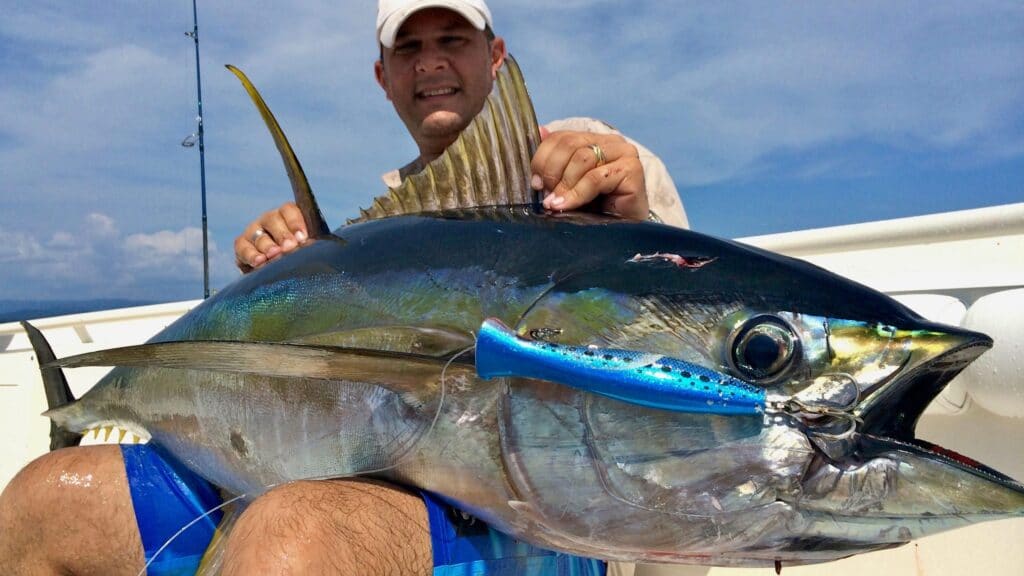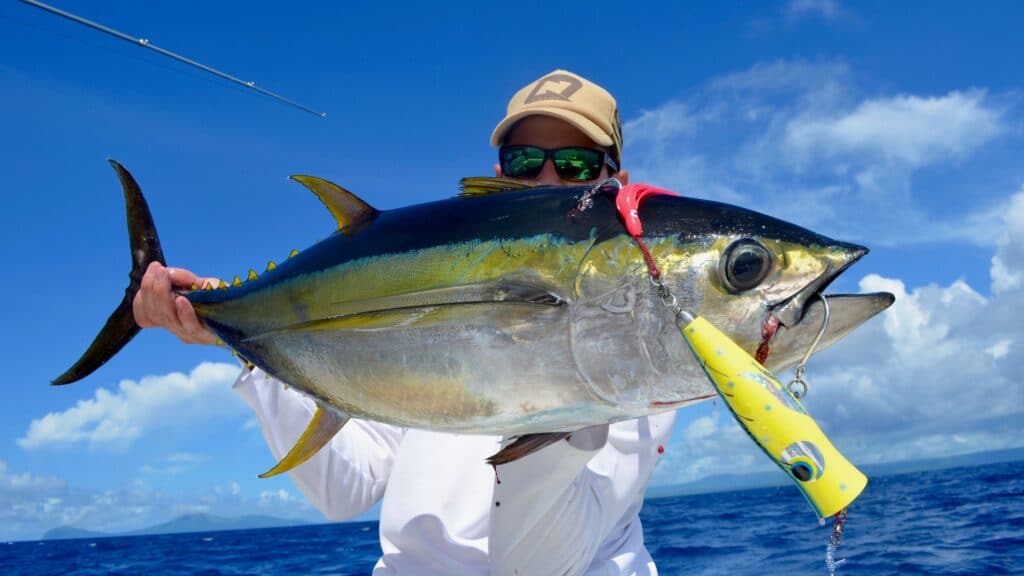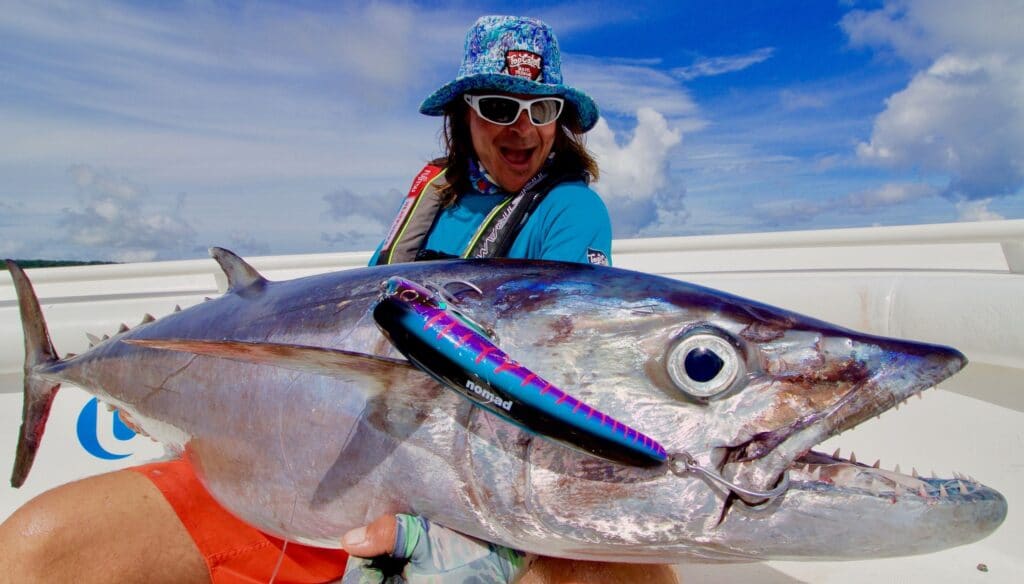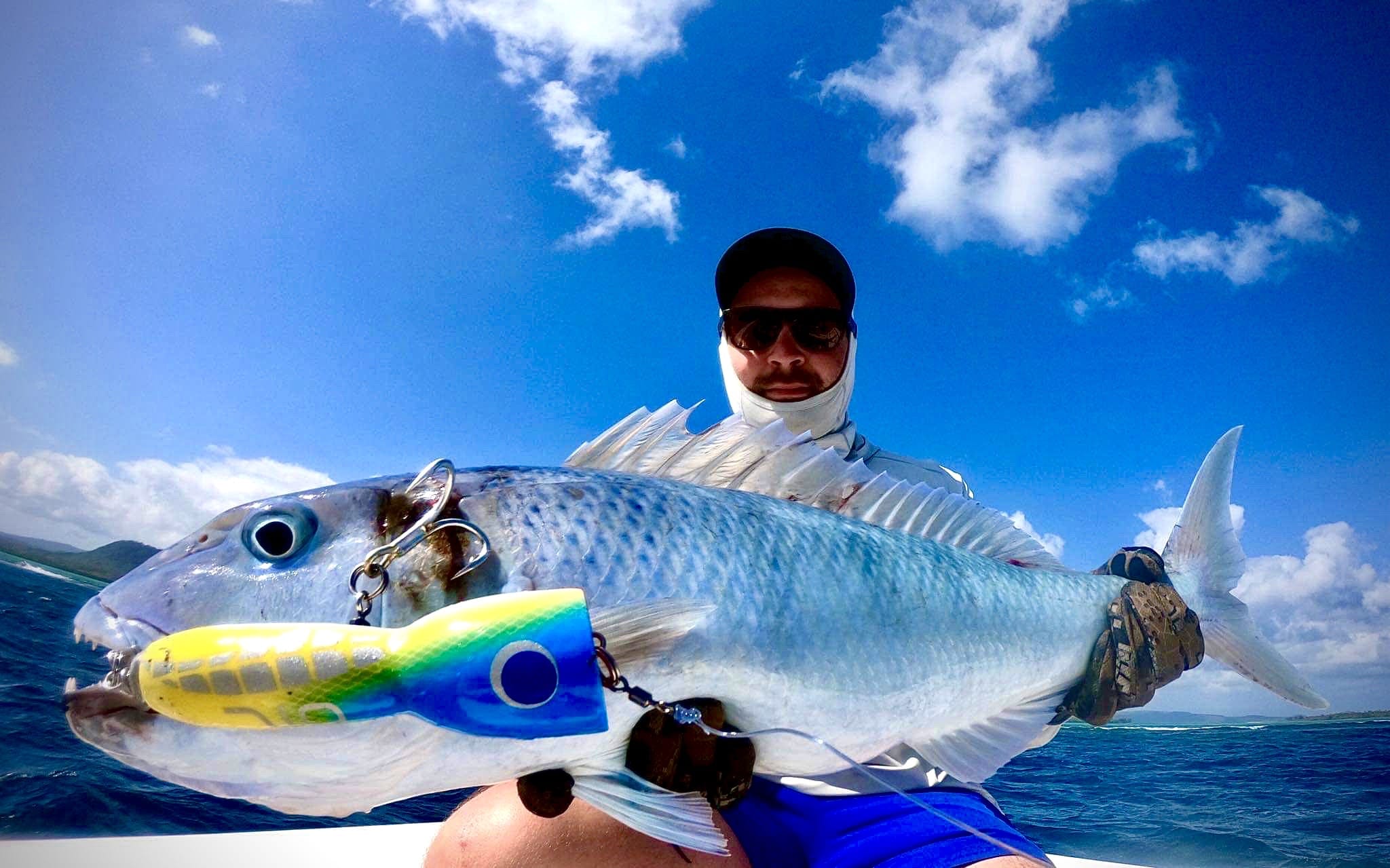Ever wondered why predatory fish aggressively take a noisy popper off the surface? Why this fishing technique is touted as the most popular when chasing some of the hardest fighting fish in the planet?
In this article, we will talk about why a popper works, what you should look for when purchasing a popper, different kinds of popper designs and how to work your poppers in different weather conditions.
Have you ever seen a GT or any other predator hit a fish on the surface and been able to see what happens to the other parts of the bait fish that’s left? Let’s break down the stages of the hit and correlate this to the action of a popper.
3 Stages:
The popper is made with a cupped face where you attach your leader to, thus creating a lot of pressure due to water tension or drag. A strong pull towards you will cause the popper to “push” water in front of it creating surface turbulence.
This surface turbulence or when the water attempts to escape the “cup” as it is being forcefully pushed away is what a lot of pelagic and reef species create when they chase down prey on the surface.
The head down to the flanks of the fish are partially out of the water – this is the start of your stroke on the popper or “the pull”. The commotion under the water or the bubble trail is the water turbulence caused by the fast swimming predator’s tail and body, what we will call “the sweep” of the stroke.
After the hit, the bait just sitting there, or pieces of it on the surface – is the pause between pops, and where you’ll most likely get a big hit.
This is the play by play called out by the commentators when you are working a popper. Three stages – the pull, the sweep and the pause. Each a very important stage.
You can place additional focus on one of the stages but cannot perform a good “pop” without one action missing.
The Pull. The Sweep. The Pause.
Types of Poppers
There are a lot of popper designs out there but we’ll focus on the 3 most popular designs that are a must-have in your tackle bag when heading out big game saltwater popping.
(We won’t touch on the pencil poppers as they have a totally different action and can be categorized as a general topwater lure rather than a popping specific lure.) We will also discuss how to impart action on each of them to achieve the most desirable effect.
1. Splashers / Chuggers
 The cups on the faces will be wide and flared out to the sides. This creates water drag but allows the water to escape to the sides of the face easily, creating a cascading splash effect 360 degrees around the poppers face.
The cups on the faces will be wide and flared out to the sides. This creates water drag but allows the water to escape to the sides of the face easily, creating a cascading splash effect 360 degrees around the poppers face.
Maximum water splash forward and upward is the goal of the design and these poppers achieve this splash any day of the week.
Apart from the big commotion it causes on the surface, the splash adds more drama to the scene once the water chucked upwards and to the sides land on the surface in big droplets, creating a “predator attacking a bait ball” effect.
How to use: Possibly the most versatile popper of the bunch as you can impart multiple popping noises on the surface depending on how you impart action on the rod.
Cast your popper out to the desired target and place your rod’s butt in the gimbal. When the popper lands on the water, your head and body should be facing the lure with legs spread wide in a staggered a bit to offer the most stability.
Staggered in a way that the foot that is below to your reeling hand is placed behind the body, anticipating a hit, bracing the body so you won’t fall backwards when the Hollywood explosions start.
Your stance is now sorted so let’s proceed to how to impart the action.
Popper in the water and rod butt in the gimbal. Your rod arm should be stretched forward almost where the elbow is locked. Rod should face the popper and so should your hand and arm point straight to the popper.
Reel in the slack line and pull back in a sharp and strong motion, like punching yourself in the chest, but stopping about 3 inches before you hit your chest.
Otherwise you’ll be short stroking or high sticking your rod. Reel in slack, sweep and pause. Repeat until you get a big hit!
You can also create a nice bubble trail by putting the rod butt under your arm and sweep. More on the bubble trail action later.
2. Bloopers / Bubble Trail Poppers
 Some will have a tighter cup face but most will be wide as well. The flare of the cups will not be as pronounced as the splashers and will mostly face forward rather than outward.
Some will have a tighter cup face but most will be wide as well. The flare of the cups will not be as pronounced as the splashers and will mostly face forward rather than outward.
The intent of the lure makers was to get the lure to produce a thick bubble trail behind the popper during the sweep stage of the pop. The initial splash won’t be as dramatic, and you’ll get more of a strong and deep ‘BLOOP’ but this allows the face to trap plenty of air resulting in a bubble trail that will definitely draw the attention of any hungry predators nearby.
More of an underwater sonic boom style of attraction which is where most of the fish are anyway.
How to use: To start the technique will be similar to the splashers with the rod butt in the gimbal. Only experience will tell you when the popper is close enough to switch to an underarm stance to get the desired effect of a thick bubble trail after a strong ‘BLOOP’.
A swift transition from gimbal to underarm is key. To start, once you’ve casted and have started popping like doing so with splashers, your lure will get closer to you and you’d want to put your rod butt under your arm, face away from the lure, ideally towards your reeling arm at a 30 degree angle from the popper to allow you to sweep sideways with your rod below parallel to the surface of the water.
A strong sideways and downwards sweep will force your popper to trap air and dive under the surface, creating a thick bubble trail.
Remember you are facing away and to the side so utilize this stance and use your upper body to help with imparting action. Arms sweep then the body twists along with the sweep to help reduce arm strain and add to the length of the sweep. Reel in slack, sweep and pause. But this time combining two different techniques.
If you try this for yourself and attempt to sweep downwards while the popper is still at max distance, you’ll find out that the action imparted is not the best as there will be too much distance between rod and popper as there will be so much water drag to get through and only so much arm and body strength from such a distance.
Again, only experience will tell you when it is the right time to switch from rod up to rod to the side.
3. Diving Poppers
 Again, these will have narrower faces compared to the conventional splashing poppers and will have a slim body profile, similar to a stickbait. The popping face will be facing upwards somewhat. Forward and upwards.
Again, these will have narrower faces compared to the conventional splashing poppers and will have a slim body profile, similar to a stickbait. The popping face will be facing upwards somewhat. Forward and upwards.
This allows the popper to dive easily after the initial pull, but still trap enough air in the face to create a nice thick bubble trail. The narrow body and narrower tail cause the plug to swim in a slashing, side to side motion, creating a zig zag bubble trail that makes us anglers crazy in love with the action, thus making this one of the most sought after styles of popper.
Maybe the most effective, maybe not. But the action looks so good from above the water, predators must think the same right?
How to use: Totally different from the standard popping styles, anglers will have their rod butts under the arms straight after the cast. Face away from the lure at a 30-degree angle from the lure towards your reeling side.
Pull and sweep sideward and downward. Pull, sweep, and pause. This will cause the popper to trap air, dive and cause a zig zag bubble trail. Cast, pull, sweep and pause. Repeat until you get a hit.
Not really sure about how the different designs and swimming action of each lure affects the caught fish as I’ve yet to interview landed fish successfully after removing a big GT recorder hooks from their mouths but I am sure that popping works extremely well when the conditions are right.
This is not a technique that will work all the time and is purely dependent on the conditions served to us by mother nature but it’s truly a technique that can pump anglers up big time giving us an adrenaline rush like no other. Nothing compares to an aggressive topwater hit.If you want to experience landing your fish of a lifetime, BOOK NOW a Vanuatu fishing adventure with Ocean Blue Fishing!
Call us now at 1300 564 616 or at (INTL) +61 436 020322 or you may also contact us through our website at https://www.oceanbluefishing.com/enquire

